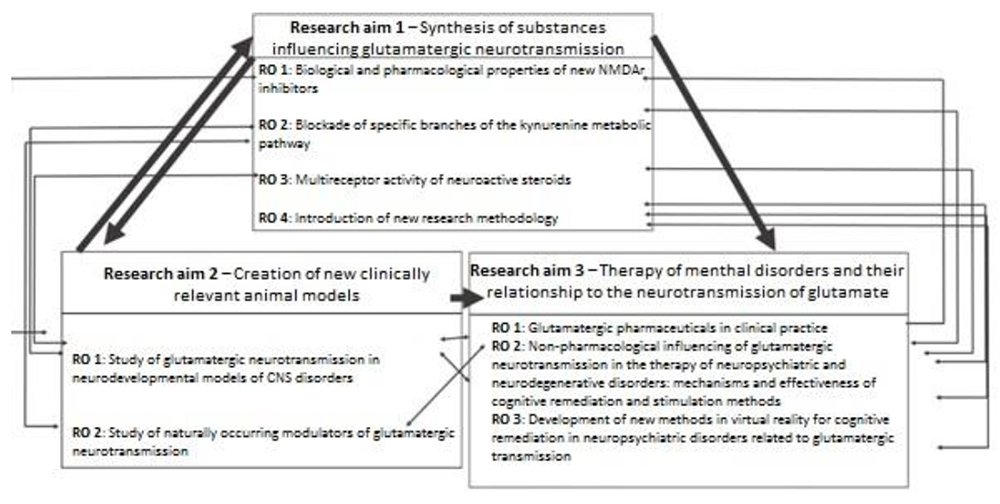Research Plan
Research aim 1: Synthesis of substances influencing glutamatergic neurotransmission 
-
Research objective 1: Biological and pharmacological properties of new NMDAr inhibitors

- Activity 1. Neuropharmacology of potential medicaments with dual modulation of the cholinergic and glutamatergic system
- Activity 2. Biological properties of new dual molecules influencing excitability of the CNS
-
Research objective 2: Blockade of specific branches of the kynurenine metabolic pathway

- Activity 1. Inhibition of production of kynurenic acid as a new antipsychotic mechanism of the effect of pharmaceuticals
- Activity 2. Antidepressant and neuroprotective influence of inhibition of quinolinic acid production
-
Research objective 3: Multireceptor activity of neuroactive steroids (E. Kudová)

- Activity 1. Neurosteroids with positive allosteric effect at NMDA receptors
Institutions/researchers involved:- Institute of Physiology CAS (IPHYS): Prof. Ladislav Vyklicky, M.D., Ph.D., D.Sc.
- Institute of Organic Chemistry and Biochemistry (IOCB): RNDr. Eva Kudová, Ph.D.
- Activity 1. Neurosteroids with positive allosteric effect at NMDA receptors
-
Research objective 4: Infrastructure for the monitoring of molecular basis of neurological disorders

- Activity 1. Monitoring of neurochemical background of CNS disorders
- Activity 2. Drug delivery systems for new API´s dual modulating cholinergic and glutamatergic system
- Activity 3. Introduction of GLP / GMP for drug synthesis
Research aim 2: Creation of new clinically relevant animal models 
-
Research objective 1: Study of glutamatergic neurotransmission in neurodevelopmental models of CNS disorders

- Activity 1. Role of inflammatory mechanism in seizure development in perinatal period
- Activity 2. Effect of perinatal stress on glutamatergic system
- Activity 3. The effect of relapses on progression of schizophrenia in novel model of psychotic relapses
- Activity 4. The role of glutamatergic neurotransmission in the development of dependency on methamphetamine
- Activity 5. The effect of the long-term tonic excitation by light et night (LAN) in early postnatal development on circadian clock maturation, brain neurochemistry and vulnerability to circadian disruption by secondary insults later in life
-
Research objective 2: Study of naturally occurring modulators of glutamatergic neurotransmission

- Activity 1. Study of Kynurenine Pathway Metabolism: Shared theory of affective and psychotic disorder pathophysiology
- Activity 2. The role of neurosteroid in development of behavioral disease
Research aim 3: Therapy of Mental Disorders and their Relationship to the Neurotransmission of Glutamate 
-
Research objective 1: Glutamatergic pharmaceuticals in clinical practice

- Activity 1. Neurobiology of the antidepressant effect of ketamine in the light of modulation of kynurenine cascade
-
Research objective 2. Non-pharmacological effects of glutamatergic neurotransmission in the therapy of neurogenerative disorders: mechanisms and efficacy of
cognitive remediation and stimulation methods

- Activity 1. Options of cognitive remediation using a progressive cognitive training for schizophrenia and bipolar disorder
- Activity 2. Options of cognitive remediation by means of a progressive cognitive training for a mild cognitive impairment
- Activity 3. Augmentation (enhancer) of pharmacotherapy using non-pharmacological methods– influencing of glutamatergic transmission in target areas of the brain (stimulation methods - rTMS, tDCS)
-
Research objective 3. Development of new methods using virtual reality for a cognitive remediation for neuropsychiatric disorders in connection with the glutamatergic
transmission

- Activity 1. Development of applications for remediation of a disrupted speed of information processing (flexibility, psychomotor tempo, cognitive coordination)
- Activity 2. Development of virtual games for a cognitive training with a focus on memory functions
- Activity 3. Development of new methods for a cognitive training for obsessive-compulsive type disorder with a focus on inhibitory control

(VC, thin arrows) of the proposed project.